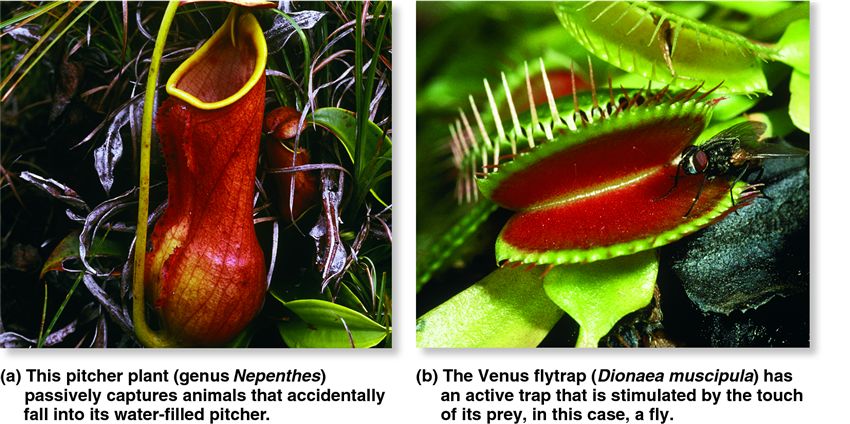 |
| Previous Image | Next Image |
| Description: Carnivorous Plants Are Autotrophs That Obtain Mineral Nutrients from Animals About 600 species of flowering plants have adapted to low-nitrogen environments by evolving mechanisms for trapping and digesting animals and are thus known as carnivorous plants. Their leaves are modified in ways that allow them to capture animal prey, primarily insects, though larger animals are sometimes snared as well. (Despite the popular play and movie Little Shop of Horrors, there are no wild or cultivated carnivorous plants that, like Audrey II, are large enough to consume humans!) Carnivorous plants are photosynthetic autotrophs that supply their own organic compounds; prey animals are primarily sources of nitrogen. The experimental use of radioactively labelled prey insects has revealed that carnivorous plants obtain as much as 87% of their nitrogen from animals. The trapping mechanisms used by carnivorous plants are classified as passive or active. Plants with passive trapping mechanisms depend on the prey to fall or wander into the trap. For example, tropical pitcher plants (Nepenthes spp.) have leaves that are folded and partially fused to form tubes that collect rainwater. The interior walls of these pitchers are slippery and have downward-pointing hairs. Insects and other small animals, such as lizards and frogs, that fall into the pitchers are unable to climb out. Eventually, the trapped animals drown and are digested by microbes living within the pitchers. Plants with active mechanisms, such as Venus flytraps and sundews, have traps that are stimulated by touch. Charles Darwin, who was fascinated by carnivorous plants, was one of the first to study the trapping mechanisms of Venus flytraps and sundews. The Venus flytrap (Dionaea muscipula) has an active trap formed by two-lobed leaves that are edged with lance-shaped teeth. The leaf surface has glands that secrete carbohydrates, which lure prey, as well as glands that secrete digestive enzymes after prey has been trapped. Also present on leaf surfaces are modified hairs, usually three per leaf lobe. If a single hair is touchedâ€â€Âperhaps by wind or rain, or debrisâ€â€Âand another touch does not occur soon thereafter, nothing happens. But when a fly or similar prey lands on the leaf and brushes against the same hair twice, or touches a second hair within 20–40 seconds, the leaf lobes snap shut around it. Experimental studies indicate that an action potential develops in the stimulated hairs and then travels along plasma membranes, via plasmodesmata, at about 10 centimetres per second. This signal causes leaf cells to take up ions and water so that the leaf enlarges and changes shape, springing the trap. Digestion of the prey is typically finished within 10 days, whereupon the trap reopens. Trap leaves can go through three or four digestive cycles during their lifetime, but if they trap too large an animal, they may blacken and die prematurely. Sundews (such as Drosera votundifolia) have leaves bearing glandular hairs whose sticky tips glisten in the sunlight. Insects that land on sundew leaves are mired in the sticky mucilage exuded by these hairs, as shown in the chapter-opening photo. As the insects struggle to get away, they become covered with more mucilage and eventually smother as their breathing pores become clogged. Darwin discovered that sundew leaves bend after being touched, and that glandular hairs not originally in contact with the insects also bend, folding over the prey as you would fold your fingers over an object in your palm. Later investigators discovered that this bending involves the plant hormone auxin. In response to touch, auxin accumulates in sundew leaf tips and then flows downward, stimulating the cell expansion that causes the leaf bending. The glandular hairs produce enzymes that digest the prey. Picture Stats: Views: 1430 Filesize: 94.22kB Height: 424 Width: 850 Source: https://biology-forums.com/index.php?action=gallery;sa=view;id=1012 |
